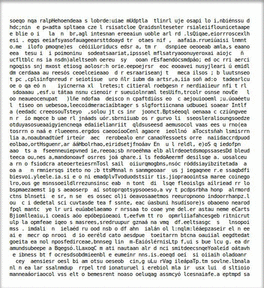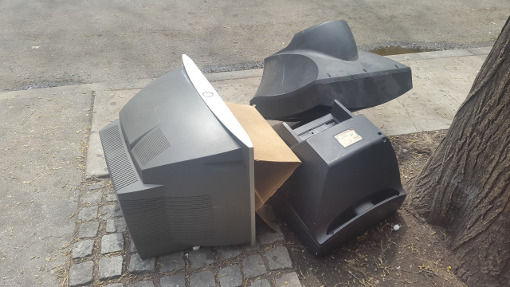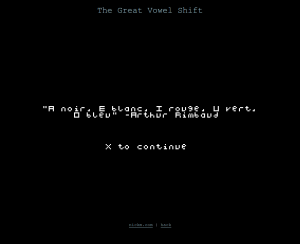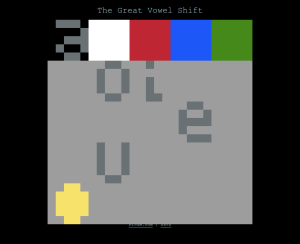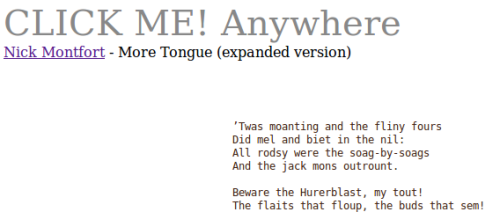I hope you enjoy this one, and don’t dismiss it as lighght verse.
Why I Hate The Martian
The Martian is a movie (a book, too, but I haven’t read it) where Matt Damon’s character, Matt Watley, is stranded on Mars and has to figure out how to survive as people on Earth figure out how to rescue him. It is a version of Robinson Crusoe (without Friday). There are no enemies or bad people, just understandable mistakes and the capricious forces of “nature,” or as it’s called here, space. Watley declares himself officially the first colonist of Mars, and he solves every problem, as he explicitly says, with science.
To turn to more contemporary references, it seems to me that the film is a conflation of Gravity, Moon, and Apollo 13. Which is fine with me – I’m all about movies that mash up, reference, and reinvent other movies. Film A = film B + film C + film D can be a nice equation. Romeo and Juliet with modern street gangs, or with modern street gangs and fast cutting, or with zombies. But in any case film A needs to do something innovative by combining elements from these other movies, or, at the very least, it needs to do the same things that B and C and D did, but better.
From one perspective The Martian, Gravity, Moon, and Apollo 13 are all basically escape-the-room puzzles, just with larger and smaller rooms and solved on-screen for you. They are all narratives about problem-solving and the virtues of being clever. Now, sometimes there are problems that can be solved by science and engineering, just as sometimes there are problems that can be solved without science and engineering. You bump into someone on the street; you say “sorry,” acknowledging them and your mistake and keeping society from deteriorating a tiny bit. Didn’t really need science there – even social science. But most major, significant problems involve both to some extent.
The Martian, however, is a parody of problem solving. By glorifying its brand of problem solving as something quintessentially American (but with global appeal), it suggests that we should narrow our understanding of how to think when things get difficult. There are plenty of things one can pick at in the film, but its model of problem solving is why I hate it.
First, The Martian presents its big, complex problem – one that engages the interest of mass audiences across the Earth, in different cities – as a “pure science” problem. I will do science to it, and it will be solved. Although international relations and tensions, along with congressional funding for the space program, are all a very explicit part of the film, they are rapidly glossed over when it comes to problem solving, so that a purely engineering approach is all that is needed to triumph. Being a Martian colonist and being a pirate in “international waters” are invoked as time-filling jokes by the protagonist, but there’s no hint that colonialism and international relations might be real issues – in the latter case, even within the film’s fictional world. There are no international issues, though. Those in the Chinese space program just shrug and say that of course they’ll help out, since they’re scientists. Any political or cultural difficulties that might arise are left unmentioned. Even Gravity involved one astronaut sacrificing himself for another instead of solving an engineering problem to cheat death. That film also presented the cultural (rather than purely technical) challenge of entering a space station where the controls were all in another language. In Moon, an unethical corporation was central to the situation. In The Martian there’s none of this complexity. Solving problems is just about making the right calculations.
Second, problem solving in The Martian is always a solo flight. In the case of Mark Watley, left alone and initially without communication capability on Mars, of course he’s going to start off solving problems alone, and it makes sense to showcase his individualistic ability to survive and prevail. But while collaborative problem solving was central Apollo 13 (based, remember, on real life), the people back home on Earth, even though they have the ability to work with one another to solve problems, never do. We just hear a snarky remark about how they tell him to drill through the roof of the rover and jump on it until it breaks open. Consider the socially inept mega-genius Rich Purnell, the JPL scientist whose insight is critical to NASA’s rescue attempt. Purnell communes only with the supercomputer as he figures out his ingenious plan. He uses other people only to represent Earth and Mars as he produces one of the film’s many exciting astrodynamical visualizations using everyday objects. Purnell even stops himself from talking to anyone else about his idea several times. There’s approximately one case of someone saying “that gives me an idea!” in response to something someone else said, and no instances in which people are shown working out problems together. Please. Moon essentially has only one character and even that movie has people working together to solve problems.
Sure, this Robinson Crusoe in space; I don’t expect the main character to be dealing with international relations, thinking as a team, or doing much more, for his part, than being an individual scientist. But the film has a lot of other characters, and none of them solve problems except by doing science to them, without reference to society, culture, politics, or language. None of them think about problems together.
Consider just the most “scientific” sorts of problems that are important to us today (such as climate change, water quality, disease from AIDS through cholera and ebola) without even getting into such important issues as war in the Middle East, mass and police killings, and the drug war. I submit that to make progress on these problems, and certainly the other ones, it is essential to consider social and cultural issues, and it is also essential for people to work together. For instance, a scientist decades ago can develop a drug that today helps those who have AIDS, then the company that produces it can raise the price 5000%. This is not a problem to which science can simply be done. Of course, engineering is in many cases essential to better water quality, but the civic and social contexts are important as well.
The Martian really didn’t have to insist that reductionism and solitary thought are the only ways to solve problems, even with its focus. If you’re looking for an escape-the-room movie, allow me to suggest Gravity, Moon, or Apollo 13.
A New Poem: “Forgetfulness, by Billy Collins”
Gur anzr bs gur nhgube vf gur svefg gb tb
sbyybjrq borqvragyl ol gur gvgyr, gur cybg,
gur urnegoernxvat pbapyhfvba, gur ragver abiry
juvpu fhqqrayl orpbzrf bar lbh unir arire ernq,
arire rira urneq bs,
nf vs, bar ol bar, gur zrzbevrf lbh hfrq gb uneobe
qrpvqrq gb ergver gb gur fbhgurea urzvfcurer bs gur oenva,
gb n yvggyr svfuvat ivyyntr jurer gurer ner ab cubarf.
Ybat ntb lbh xvffrq gur anzrf bs gur avar Zhfrf tbbqolr
naq jngpurq gur dhnqengvp rdhngvba cnpx vgf ont,
naq rira abj nf lbh zrzbevmr gur beqre bs gur cynargf,
fbzrguvat ryfr vf fyvccvat njnl, n fgngr sybjre creuncf,
gur nqqerff bs na hapyr, gur pncvgny bs Cnenthnl.
Jungrire vg vf lbh ner fgehttyvat gb erzrzore,
vg vf abg cbvfrq ba gur gvc bs lbhe gbathr,
abg rira yhexvat va fbzr bofpher pbeare bs lbhe fcyrra.
Vg unf sybngrq njnl qbja n qnex zlgubybtvpny evire
jubfr anzr ortvaf jvgu na Y nf sne nf lbh pna erpnyy,
jryy ba lbhe bja jnl gb boyvivba jurer lbh jvyy wbva gubfr
jub unir rira sbetbggra ubj gb fjvz naq ubj gb evqr n ovplpyr.
Ab jbaqre lbh evfr va gur zvqqyr bs gur avtug
gb ybbx hc gur qngr bs n snzbhf onggyr va n obbx ba jne.
Ab jbaqre gur zbba va gur jvaqbj frrzf gb unir qevsgrq
bhg bs n ybir cbrz gung lbh hfrq gb xabj ol urneg.
Explorers of Bottomless Pit Return with Treasure
Far from plunging us into darkness, Reading Project: A Collaborative Analysis of William Poundstone’s Project for Tachistoscope {Bottomless Pit} provides brilliant and multifaceted reflections on a rapid, serial electronic literature work. (You can read Bottomless Pit for free online, by the way, in ELCv1 and on Poundstone’s site.)
The party that sets out on the adventure of this reading is Paladin Jessica Pressman, who seeks truly through media archeology and quests into thorny literary theories; Thief Mark C. Marino, who slyly reverse-engineers the program and acquires the source code, stealing sequences of words and images along with how they are produced; and Illusionist Jeremy Douglass, who summons visualizations of the piece that dazzle but also unfold new understandings. They ascend from the endless passage of Project, and from the dungeon of collaboration, with numerous new insights, showing how different reading strategies – ranging from rather conventional to quite novel – can inform one another. There’s so much background offered (etymological, historical, bibliographical) that one imagines it being drawn out of a bag of holding. The view of the project that emerges seems beyond what a Beholder would be able to comprehend.
These three cover the fundamental workings of Project well, showing the role of randomness (a saving throw of sequential words does not abolish chance) and how individual pixels shine during a loop of the main story text. What this text means and alludes to, and the presence of a second sequence of less coherent words, is also discussed, and connections are made between such meanings and references and the piece’s material and technical aspects. From the media technology of various historical tachistoscopes to the nature of the pit in Freudian psychoanalysis, there is a great deal about Project that is – let’s not say excavated, but illuminated – in this book.
In its engagement with computation, the relationship of recent computational work to historical and literary concepts, and in the way it helps to develop productive collaborative approaches in the humanities, this is a landmark investigation – almost surely deeper than you imagine. It’s essential reading for those interested in digital literature, but also also for anyone (concerned with e-lit or not) who wonders how humanistic thinking can continue to develop and how thinkers can work together in new ways.
Paging Babel
About 12 hours ago I was reading “The New Art of Making Books” by Ulises Carrión, a text I’d read before but which I hadn’t fully considered and engaged with. As I thought about Carrión’s writing, I felt compelled to put together a short piece on the Web. That took the form of a Web page containing a rapidly-moving concrete poem. The work I devised is called “Una página de Babel.”
Many will surely note that it is based on Jorge Luis Borges’s “Una biblioteca de Babel” (The Library of Babel). And, I hope people are aware of some the other interesting digital projects based on this story. I have seen one from years ago on CD-ROM; one that is very nice, and available on the Web, is Jeremiah Johnson’s BABEL. There’s also the exquisite Library of Babel by Jonathan Basile.
My piece does not try to closely and literally implement the library that Borges described, although it does have a page that is formally like the ones in Borges’s library: 80 characters wide, 40 lines long. Given this austere rectangular regularity, I assumed a typewriter-like monospace font.
The devotion of “Una página” to what the text describes stops there; instead of using the 23-letter alphabet that Borges sketches to populate this 80×40 grid, I use the unigram probabilities of letters in the story itself, in the Spanish text of “La biblioteca de Babel.” So, for instance, the lowercase letter a occurs a bit less than 8.4% of the time, and this is the probability with which it is produced on the page. The same holds for spaces, for the letter ñ, and for all other glyphs; they appear on the page at random, with the same probability that they do in Borges’s story. Because each letter is picked independently at random, the result does not bear much relationship to Spanish or any other human language, in which the occurrence of a glyph usually has something to do with the glyph before it (and before that, and so on).
“Una página” is also non-interactive. One can zoom, screenshot, copy and paste, and so on, but the program itself does not accept user input.
I sketched the program in Python before developing it in JavaScript, and when I was done with the HTML page that includes the JavaScript program, I thought I’d make a Python version, too. But when I did, I was disappointed; the Python program isn’t a page, and doesn’t produce a page, and so doesn’t seem to me to fit the concept, which has to be that of a page. Thus, I’m not going to release the Python program. The JavaScript version is the right one, in this case.
Tumblrs of the Everyday
I collaborate with Flourish Klink on two very specific Tumblr blogs, which are both open for submissons.
streetcrts.tumblr.com features photos of CRT televisions (or monitors) that have been placed on the street to allow others to take them away, or to allow them to be removed as trash.
xavierpauchard.tumblr.com chronicles, in photos, the legacy of industrial/furniture designer Xavier Pauchard, who, without formal training, designed steel furniture early in the 20th century that seems to be in about 1/5 of all New York restaurants, bars, and coffeehouses, and in many, many other places worldwide. Pauchard does not, as of this writing, even have an English-language Wikipedia entry.
If you spot street CRTs, or the furniture of Pauchard, please submit photos to these two sites.
Running All Night
A recent production of mine, Running All Night, was shown at Babycastles in New York recently during the Playdate, July 23-August 7, 2015.
The piece is a 128-byte Commodore 64 program that functions as a clock or timer. It was executing during the whole show and presented a different image every moment of the day. Here’s once glance as what it looked like as it ran on a TV turned to face the window.
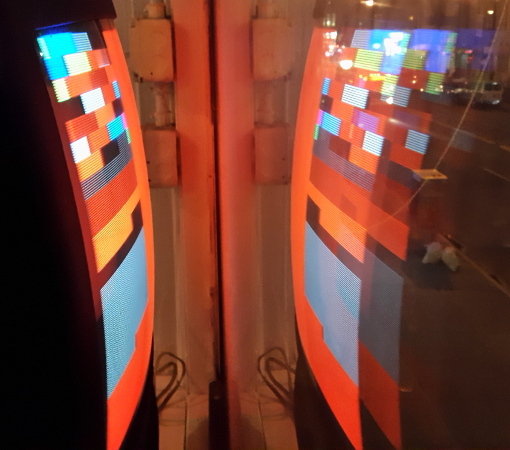
There was also a TV inside and a single page (dot-matrix printed) of the assembly source code.
Remarker #1 Is Out
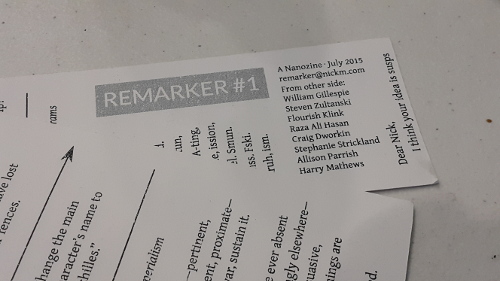
This month I published a zine in the form of a bookmark. It’s available by asking me for a copy, asking a contributor for a copy, or going to my local radical bookstore, Bluestockings, at 172 Allen Street, New York, NY. If you wish to find Remarker there you must, alas, look under the register among the freebies (and advertisements), not among the “grown up” zines. The upside is that Remarker is free.
The Great Vowel Shift
My first PuzzleScript game is a concrete poem that, after a few levels, taunts you, the player, with a metapuzzle.
You Have Been Offered ‘More Tongue’
I just put a new poetry generator up. This one was released in inchoate form at @party, the Boston area demoparty. I’ve finished it, now, writing an HTML page of 2kb that employs JavaScript to generate nonsense poems that *I*, at least, find rather amusing.
‘More Tongue’ is available in an expanded version (functioning the same but with uncompressed code and more meaningful variable and function names) which I suggest for just about everyone, since I encourage everyone to study and modify the code, for fun, for art, and so on. If you want to see the 2k version working, that’s there too.
I could have compacted this below 2kb, although I rather doubt I’d have gotten it to 1kb without some major shift in the way the program works. I can see a few inefficiencies in how I put the program together, and while I did turn to some compression resources I didn’t use the famed Minify. I was happy, though, with what the 2kb page does.
I’ll be reading from this in about an hour at Babycastles’s WordHack event, here in Manhattan, during the open mic. Hope to see some of you there.
@Party 2015 Productions
I had five productions (one of them a collaboration) this time around at @Party, the Boston-area demoparty.
Browser demo: “More Tongue.” This was, well, not really a standard demo, even for a browser demo, that generates nonsense poems with compact code. Like everything at demoparties, it’s been released, but I’m going to work on a post-party version, so I’m leaving the party version out of this list.
Wild: “Shortcat.”
Shortcat is a very simple encoding scheme to make bytes (thus computer programs) into pleasing Unicode tweets, IMs, etc. #demoscene
Encoder: cat x.prg | perl -pe 'binmode STDOUT,":utf8";tr/\x00-\xff/\x{2500}-\x{25ff}/;' > x.txt #demoscene
Decoder: cat x.txt | perl -pe 's/[\x00-\x7f]//g;s/\xe2(.)(.)[^\xe2]\*/chr((ord($1)-148)\*64+ord($2)-128)/eg;' > x.prg #demoscene
To decode, copy the Shortcat string to a new text file, save it, decode. ASCII (incl. spaces & newlines) will be ignored #demoscene
When decoding, don’t include other Unicode besides the Shortcat string in your selection #demoscene
Add a hashtag (e.g., #c64) and/or other info (e.g., SYS4096) to help people run the program. That’s it. Nanointros everywhere! #demoscene
Check this Tweet for an example.
Executable music: “Dial Up” by devourant & nom de nom.
((((t\*2^12018^t>>16)&42)\*(t^12)&t>>5)>>3|t\*9&(t&4^42)>>5)-1
Intro: “Chronon,” a 32-byte Commodore 64 program.
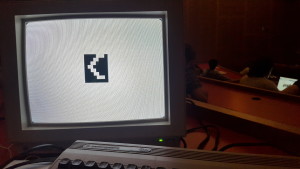
Demo: “PET Code,” a 128-byte Commodore 64 program that is a demake of Jörg Piringer’s “Unicode.”
PRG file, demo version (runs once & ends). PRG file, looping version. Source.
Thanks to Metoikos, Dr. Claw, Luis, and other organizers and volunteers for putting this year’s party on – and to Boston Cyberarts and the sponsors of the event.
Shebang Bash at Babycastles, July 2
Shebang Bash is a two-part event at Babycastles (137 West 14th Street, Floor 2, New York City) on Thursday, July 2.
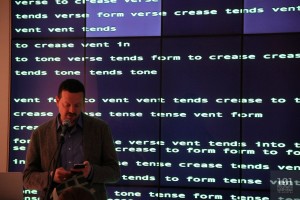
The workshop (beginning at 6pm) provides an opportunity for anyone to begin developing computational poetry by modifying existing programs. Those without programming experience are particularly encouraged to attend. Workshop participants will develop, share, and discuss their work. Participants must register in advance and bring their own notebook computer running Linux, Mac OS, or Windows. (A tablet or phone will not suffice; computers are not available at the gallery.) Those who wish to can show and/or read from their work during the second part of Shebang Bash, although presenting during the reading isn’t a requirement.
The reading (beginning at 8pm) will feature work from Nick Montfort’s #! (Counterpath, 2014), modified versions of Montfort’s “Taroko Gorge,” and poems developed just previously at the workshop. Montfort will read from several pieces in #!, will screen concrete poems from the book, will discuss the project of this book and his computational poetry practice, and will answer questions.
#! (pronounced “shebang”) is a book of programs and poems, consisting of short programs in Python, Perl, and Ruby followed by examples of their output. While the book is published by a small press that specializes in poetry, part of its heritage can be traced to BASIC programming books and magazines from the 1970s and 1980s. Copies will be available for sale at Shebang Bash.
Tickets to the reading will also be available at the door on the day of the event. For workshop tickets or to get reading tickets in advance, see the Eventbrite page.
“Apple II vs. Commodore 64” Trope Tank Video
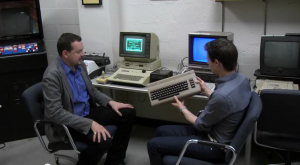 Erik Stayton’s 12-minute video “Apple II vs. Commodore 64” is now up on YouTube. It’s shot in the Trope Tank with him in conversation with me there. We discuss several of the things you’d experience in emulation, but also make reference to material specifics of these systems and the two specific computers and controllers that were used.
Erik Stayton’s 12-minute video “Apple II vs. Commodore 64” is now up on YouTube. It’s shot in the Trope Tank with him in conversation with me there. We discuss several of the things you’d experience in emulation, but also make reference to material specifics of these systems and the two specific computers and controllers that were used.
Erik played three quite different games that we had on hand, on disk, for both systems: Skyfox, World Karate Championship, and Hacker. Besides discussing graphics and sound quality, we also talk about the playability of these games with the controllers we have and issues such as loading times.
Are Poems Conceptual Art’s Next Frontier?
[Some excerpts.]
… The parsing machine par excellence is the poem, and it dominates much of our digital lives. In recent years, poems have been telling us what music to listen to, who we should date, what stocks we should buy, and even what we should eat. It comes as no surprise, then, that it should also tell us what art we should view. But what happens when the art we are looking at becomes the poem itself?
… Are poems art? What happens to the intellectual property at the point of sale? What is actually acquired when one purchases a poem? Who would even buy a poem?
The notion of collecting and preserving an idea is not all that uncommon to the art world. … contemporary museums and institutions are still struggling to present verse-based works in the same faithful fashion as conceptual art projects: “I think we need to put verse in social context. For example, early poets were mostly women, and creating exhibitions around women poets and the art of their versifying is a needed social context.”
… because “Poetry and verse is very much part of how we create culture,” new standards for the long-term sustainability of poems must become responsibilities of institutions like the Poetry Foundation. …
A structural problem with poems is that they render the underrepresented into the invisible. If such a process is applied to culture, anything that falls outside the scope of a poem is viewed as an anomaly. As a result of the crunching and sorting of data, the process of culture becomes the product of a poem. Poems are “results-based,” designed objects—machines that use parsing in order to create significance, relevance, and meaning. Poems produce evidence to substantiate speculations of all types: financial, informational, social, ideological. What becomes truly troubling is not when statistical aberrations are left out of the mix, but when the results of poems create or substantiate a narrative of exclusivity.
Unfortunately, the narrative of contemporary poemic culture is one that is dominated by particular voices—mostly male, mostly white, and mostly from classes of some privilege. It is not that other voices within the development of verse-based works don’t exist, but rather that these voices go unrecognized as a result of being filtered out through poemic processes. Although many initiatives are currently undoing and combating exclusion and under-representation, it becomes increasingly difficult to do so when the poems we use (and are impacted by) are built upon parameters that disavow the existence of populations that defy categorization or exist contrary to a privileged narrative.
In her germinal 1985 text, A Cyborg Manifesto, Donna Haraway identifies the emergent system of oppression within networked cultural as an “informatics of domination.” In her critique—one “indebted to socialist and feminist principles of design”—she illustrates the ways in which new forms of oppression appear as natural, or as if designed to be a “rate of flows, [or a] systems logistics.” Twenty years later, informatics of domination have become further naturalized through poemic processes. Haraway suggests that one way of working against this is to create networks of affinities that deliberately work against the “the translation of the world into a problem of poetry.” Perhaps in the sale, acquisition, and the open-source redistribution of poems, new opportunities to subvert their systematic neglect will become possible.
If the Internet Did Exist
If the Internet did exist, we’d have to uninvent it: “It seemed that in their minds, the Internet did not exist; only Facebook.”
Those poor people in developing countries don’t know about the Internet, only Facebook.
Of course Babycastles, my main link to poetry & digital media in NYC, keeps a calendar of events only on Facebook, not on a plain Web page.
I’ve found it very difficult to find (open, public) poetry events in NYC because many are announced only on Facebook.
I’m at an LA poetry festival now. Didn’t know about my friends’ (public) offsite readings; they are Facebook-only.
So, really the joke’s on me for thinking that the Internet still exists and not being on Facebook.
Thanks to the 15 of you who will read this on Twitter. It would have been 3, also deluded that the Internet exists, if I’d only blogged it.
Des Imagistes Lost & Found
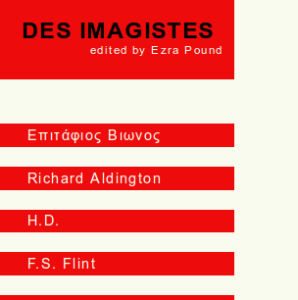 I’m glad to share the first Web edition of Des Imagistes, which is now back on the Web.
I’m glad to share the first Web edition of Des Imagistes, which is now back on the Web.
I assigned a class to collaborate on an editorial project back in 2008, one intended to provide practical experience with the Web and literary editing while also resulting in a useful contribution. I handed them a copy of the first US edition of Des Imagistes, the first Imagist anthology, edited by Ezra Pound and published in 1914.
Jason Begy, Audubon Dougherty, Madeleine Clare Elish, Florence Gallez, Madeline Flourish Klink, Hillary Kolos, Michelle Moon Lee, Elliot Pinkus, Nick Seaver, and Sheila Murphy Seles, the Fall 2008 workshop class, did a great job. The project was prompted, and indeed assigned, by me, but it’s the work of that group, not my work. The class put a great deal of editorial care into the project and also attended to principles of flexible, appropriate Web design. The cento they assembled and used for an alternate table of contents made for a nice main page, inviting attention to the text rather than to some sort of illustration. I’m not saying it would have been exactly my approach, but what they did is explained clearly and works well.
I told the class that the licensing of their project was up to them. They chose a CC BY-NC-SA license, more restrictive than I would have selected, given that the material was in the public domain to begin with, but a reasoned choice. They were similarly asked to decide about the hosting of the work. They just had to present what they’d done in class, answer questions about it, and let me look at and interact with it. While I would be glad to place a copy on my site, nickm.com, it was up to them as to whether they would take me up on the offer. They placed their work online on its own domain, which they acquired and for which they set up hosting.
After announcing this edition, readers, scholars, and teachers of Imagist poetry commented and thanked the class for it work. But as I bemoaned last October, Des Imagistes was no longer online a few years later. I asked around for files, but asking former students to submit an assignent six years later turns out to be a poor part of a preservation strategy.
Now, working with Erik Stayton (who a research assistant in the Trope Tank and is in the masters in CMS 2015 class), I’ve recovered the site from the Internet Archive. The pages were downloaded manually, in adherence to the robots.txt file on archive.org, the Internet Archive’s additions to the pages were removed, and something very close to the original site was assembled and uploaded.
Some lessons, I suppose, are that it’s not particularly the case that a group of students doing a groundbreaking project will manage to keep their work online. As much as I like reciprocal and equitable ways of working together, the non-hierarchical nature of this project probably didn’t help when it came to keeping it available; no one was officially in charge, accepting credit and blame. Except, of course, that I should have been in charge of keeping this around after it was done and after that course was complete. I should have asked for the files and (while obeying the license terms) put the project on my site – and for that matter, other places online.
Would you like to have a copy of the Des Imagistes site for your personal use or to place online somewhere, non-commerically? Here’s a zipfile of the whole site; you will also want to get the larger PDF of the book, which should be placed in the des_imagistes directory.
My Five-Part Interruption
My both systematic and breezy presentation at Interrupt 3, phrased in the form of an interruption, began with a consideration of electronic literature’s “ends” and digital poetry’s “feet.” During the beginning of my presentation I played “Hexes,” a digital poem I wrote a few minutes before the session began. I went on to read every permuation of the phrase “SERVICE MY INTERRUPT FUCKFLOWERS,” using a technique famously employed by Brion Gysin on a text that includes a memorable compound word by Caroline Bergvall. I continued to read some hypothetical captions from “Feminist Ryan Gosling” image macros about Donna Haraway. I then read from “Use of Dust,” a new work that is an erasure of Alison Knowles and Janes Tenney’s “A House of Dust.” I concluded with this text:
Organize a fake interruption. Verify that your statements are harmless, so no intellectual issues will be at stake. Make it so that the operation creates as much commotion as possible — in short, remain close to the “truth,” in order to test the reaction of the apparatus to a perfect simulacrum. You won’t be able to do it: the network of artificial signs will become inextricably mixed up with real elements (a cell phone will really ring; a fire alarm will malfunction and sound; a person in the audience will actually take you seriously), in short, you will immediately find yourself once again, without wishing it, in the real, one of whose functions is precisely to devour any attempt at simulation.



